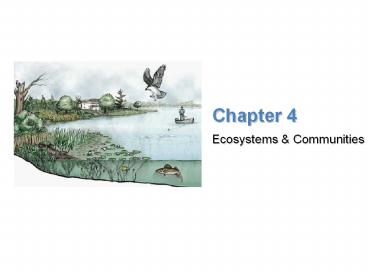Ecosystems - PowerPoint PPT Presentation
Title:
Ecosystems
Description:
Chapter 4 Ecosystems & Communities Weather and Climate Weather is the day-to-day condition of Earth s atmosphere. Climate refers to average conditions over long ... – PowerPoint PPT presentation
Number of Views:111
Avg rating:3.0/5.0
Title: Ecosystems
1
Chapter 4
- Ecosystems Communities
2
Weather and Climate
- Weather is the day-to-day condition of Earths
atmosphere. - Climate refers to average conditions over long
periods and is defined by year-after-year
patterns of temperature and precipitation.
3
Factors That Affect Climate
- What factors determine global climate?
4
1. Solar Energy and the Greenhouse Effect
- Earths temperature is largely controlled by
concentrations of three atmospheric gasescarbon
dioxide, methane, and water vapor. - These greenhouse gases function like glass in
a greenhouse, allowing visible light to enter but
trapping heat through a phenomenon called the
greenhouse effect.
5
2. Latitude and Solar Energy
- Near the equator, solar energy is intense, as the
sun is almost directly overhead at noon all year.
Thats why equatorial regions are generally so
warm. - Earths polar areas annually receive less intense
solar energy, and therefore heat, from the sun. - The difference in heat distribution creates three
different climate zones tropical, temperate, and
polar.
6
3. Heat Transport in the Biosphere
- The unequal distribution of heat across the
globe creates wind and ocean currents, which
transport heat and moisture.
7
THINK ABOUT IT
- Why does the character of biological communities
vary from one place to another? - Why, for example, do temperate rain forests grow
in the Pacific Northwest while areas to the east
of the Rocky Mountains are much drier? - How do similar conditions shape ecosystems
elsewhere?
8
Defining Biomes
- Ecologists classify Earths terrestrial
ecosystems into at least ten different groups of
regional climate communities called biomes. - Biomes are described in terms of abiotic factors
like climate and soil type, and biotic factors
like plant and animal life.
9
Defining Biomes
- The map shows the locations of the major biomes.
10
The Niche
- What is a niche?
11
Defining the Niche
- An organisms niche describes not only the
environment where it lives, but how it interacts
with biotic and abiotic factors in the
environment.
12
Competition
- How does competition shape communities?
- When niches overlap too much, it causes species
to divide resources - competition helps determine the number and kinds
of species in a community and the niche each
species occupies.
13
Dividing Resources
- Instead of competing for similar resources,
species usually divide them. - For example, the three species of North American
warblers shown all live in the same trees and
feed on insects. - But one species feeds on high branches another
feeds on low branches, and another feeds in the
middle.
14
Symbioses
- Any relationship in which two species live
closely together is called symbiosis, which means
living together. - The three main classes of symbiotic
relationships in nature are mutualism,
parasitism, and commensalism.
15
Mutualism
- A relationship between species in which both
benefit is known as mutualism.
16
Parasitism
- Parasitism relationships in which one organism
lives inside or on another organism and harms it.
17
Commensalism
- Commensalism a relationship in which one
organism benefits and the other is neither helped
nor harmed.
18
Predation Herbivory
- How do predation and herbivory shape
communities?
19
Predator-Prey Relationships
- An interaction in which one animal (the
predator) captures and feeds on another animal
(the prey) is called predation. - Predators can affect the size of prey
populations in a community and determine the
places prey can live and feed.
20
Primary and Secondary Succession
- How do communities change over time?
21
Primary and Secondary Succession
- Ecological succession is a series of
more-or-less predictable changes that occur in a
community over time.
22
Primary Succession
- Succession that begins in an area with no
remnants of an older community is called primary
succession.
23
Primary Succession
- The first species to colonize barren areas are
called pioneer species.
24
Secondary Succession
- Sometimes, existing communities are not
completely destroyed by disturbances. In these
situations, secondary succession occurs.






























